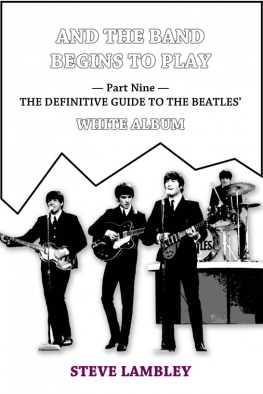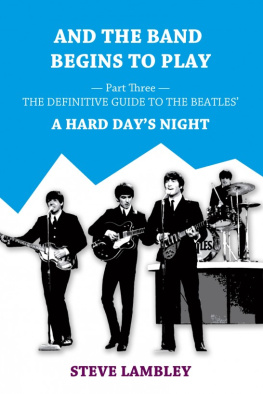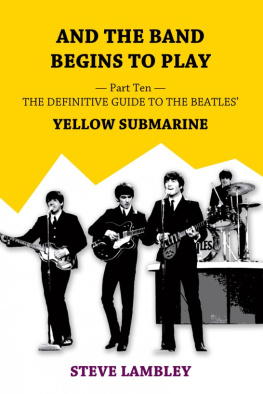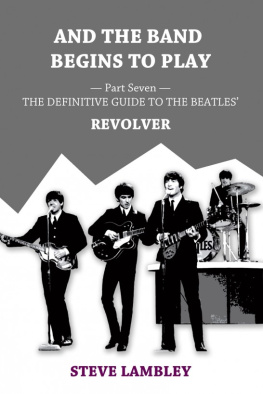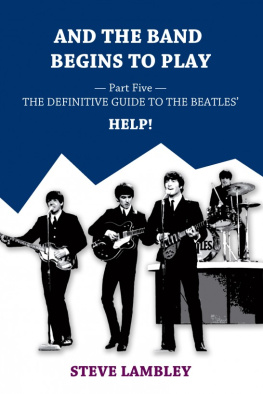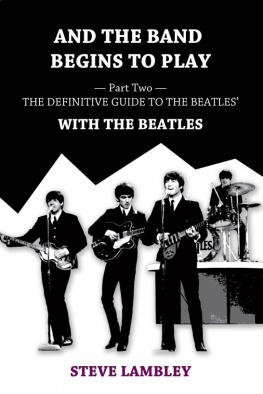AND THE BANDBEGINS TO PLAY
Part Four The Definitive Guide to the Beatles BEATLES FORSALE
by
SteveLambley
Published bySLIDE Books
Version 2.0
Steve Lambley2014
All song lyricsremain the copyright of their respective owners, and are quoted forthe purposes of scholarship, under fair dealing and fair usagelaws. No infringement is intended.
No part of thisbook may be reproduced in any form without written permission fromthe copyright holder.
SmashwordsEdition, Licence Notes
This ebook islicensed for your personal enjoyment only. This ebook may not bere-sold or given away to other people. If you would like to sharethis book with another person, please purchase an additional copyfor each recipient. If youre reading this book and did notpurchase it, or it was not purchased for your use only, then pleasereturn to Smashwords.com and purchase your own copy. Thank you forrespecting the hard work of this author.
Table ofContents
Single release
Parlophone R 5200 Released 27 November 1964
I Feel Fine
[Lennon-McCartney]
Recorded 18 October
Mixed 21 October (mono), 4 November (stereo)
John leadvocals, lead/rhythm guitar
Paul harmony/backing vocals, bass
George harmony/backing vocals, lead/rhythm guitar
Ringo drums
So, how do youfollow up an intro as extraordinary as that of A Hard DaysNight? With
the recordwith the first feedback anywhere. I defy anybody to find a record unless its some old blues record in 1922 that uses feedback thatway. I mean, everybody played with feedback on stage, and the JimiHendrix stuff was going on long before. In fact, the punk stuff nowis only what people were doing in the clubs. So I claim it for theBeatles. Before Hendrix, before The Who, before anybody. The firstfeedback on any record.
Acharacteristically extravagant claim from John, but as far ascommercial releases are concerned, he is right. But, of course,theres much more to the song than an audio gimmick. John seems tohave been going all out to yet again bag the next single althoughhe was pushing at a slightly open door because so far only Love MeDo and Cant Buy Me Love had been predominantly Paul singlereleases. So the song is unusually straightforward in its messageof being happy being in love. The closest to its soaring sentimenthad probably been I Want To Hold Your Hand, but that stillevinced a yearning to get even closer. I Feel Fine, for all thelaid back understatement of its title, was about how thingscouldnt really get much better. Set against the magicalcombination of John and Georges jagged guitar duetting and Ringosdeft, light touch, together with some wonderfully matched vocalharmonies, the song still sounds years ahead of its time.
But while IFeel Fine is a thoroughly individual single, it is also builtaround a number of Beatle clichs and is, on paper, in many waysrelatively standard fare. This is particularly true of the melodicand harmonic form of the song, which is based around a narrow rangeof notes and chords. Most of the song is contained within a rangeof about four notes, and the song comprises essentially only fourchords, rooted in its key of G major. Blue notes are also usedfairly predictably, with flattened sevenths prominent near thebeginning of the verse, and a flattened third providing the pivotfor the climax.

The strongpresence of the fourth (C) in both the guitar riff and the melodyof the verse creates a dynamic that the Beatles were to exploitmore and more.
Harmonically,the verses six-bar GD (IV) is capped by a four-bar DCG(VIVI). The bridge adds a little extra variety, though not agreat deal, throwing in a Bm (iii) to heighten the gladness. Butessentially and unusually the whole song, verse and bridge, isin the key of G. The repeated Cs that John sings in the versecreates a certain dissonance with the G chord that leads to afeeling of urgency. The introductory feedback, incidentally, alsoprovides a degree of added (probably unintentional) harmonicinterest. The note plucked is an A, which is followed the D chord and A is the dominant of D, which is the dominant of G.
The deceptivelycomplex riff is based on the track Watch Your Step by theAmerican R&B singer/songwriter Bobby Parker, released in 1961.John acknowledged that he also used the riff to produce licks forTicket To Ride and Day Tripper.
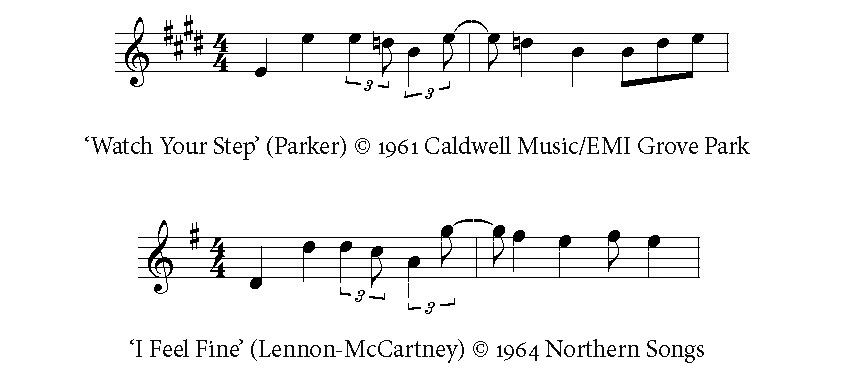
Encouraged towrite a song around the riff, John was initially uncertain of themerits of I Feel Fine. Ive written this song, he recalledtelling Ringo on entering the studio, but its lousy.
George hascited the song as an example of a communally written song for whichhe received no credit. We were crossing Scotland in the back of anAustin Princess, singing Matchbox in three-part harmony. And itturned into I Feel Fine. The guitar part was from Bobby ParkersWatch Your Step, just a bastardised version. I was there for thewhole creation but its still a Lennon-McCartney.
Ringoscontribution should not be forgotten something of ahi-hat/tom-tom duet with a hint of the calypso. His developmentinto a key player in the creation of the Beatles sound did not gounnoticed by George Martin. He was always trying out differentideas, to give a little piquancy to the arrangements.
But thecharacter of the song is immediately laid on the line by thatintroductory feedback, and theories abound as to where the ideacame from. Described at the time as an accident in the studio, MarkLewisohn points out that take 1 of the recording had the feedbackintro and the timing and sound quality is identical to the finalrelease indicating the idea was already in place when recordingbegan. But it could nevertheless have initially been an accident inthe studio, as the Beatles did at various times capitalise onmusical accidents. Geoff Emerick remembers being told by NormanSmith that they had chanced upon the sound when recording EightDays A Week, twelve days earlier (during a session in which Johncan be heard for the first time working through the riff to I FeelFine). During a break, John had leaned his guitar against hisamp, but had neglected to turn down the volume of the pickup. Justat that moment, for no particular reason, Paul had plucked a lowA on his bass and, from across the room, the sound waves setJohns guitar feeding back. Paul, in turn, clearly remembers Johnresting his guitar on the amp, (I can still see him doing it) butwithout the plucked A. The phenomenon of feedback itself wasobviously well known at the time, being a hazard of playing live.And, as John said, everybody was using it on stage. But did Johnconsciously steal the idea from the likes of the Who, as somecommentators claim, or was it truly serendipitous, as the insiderswould have it? Who knows. Either way, I Feel Fine kicks in with aplucked A on Pauls bass, followed by the resonance an octavehigher of the guitars A string, driven by the sound from the bassamplifier.
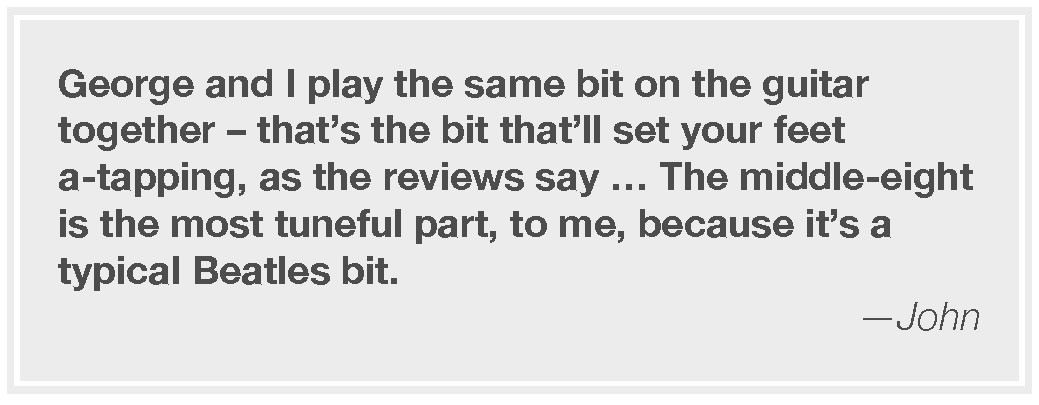
And that firsttake of the song also neatly points up the danger of over-analysis.We can happily deconstruct the song decades later and marvel at howJohn piled dominant upon dominant at the beginning of the song toproduce harmonic interest and that even this was doneintuitively. But the inconvenient truth is that take 1 of the songwas in the key of A, the same as the plucked bass note. It was thenlowered to the key of G all the better to suit Johns vocalrange.
Next page
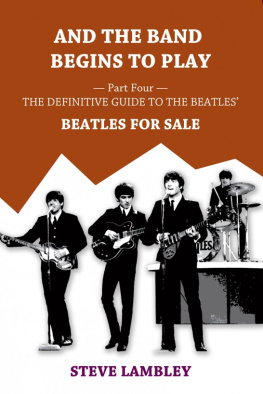
![Lambley - And the Band Begins to Play: [Part1 The Definitive Guide to the Beatles Please Please Me]](/uploads/posts/book/213741/thumbs/lambley-and-the-band-begins-to-play-part1-the.jpg)
![Lambley - And the Band Begins to Play: [Part9 The Definitive Guide to the Beatles White Album]](/uploads/posts/book/213743/thumbs/lambley-and-the-band-begins-to-play-part9-the.jpg)
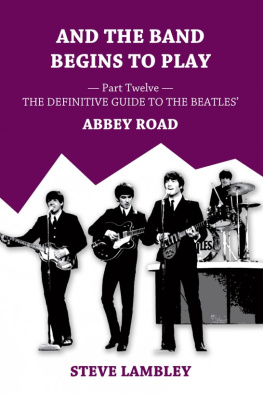


![Lambley - And the Band Begins to Play: [Part6 The Definitive Guide to the Beatles Rubber Soul]](/uploads/posts/book/213742/thumbs/lambley-and-the-band-begins-to-play-part6-the.jpg)
